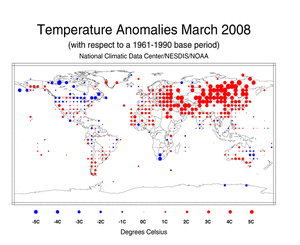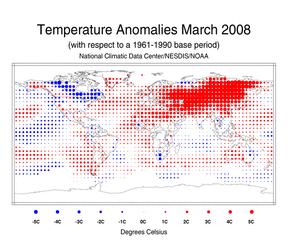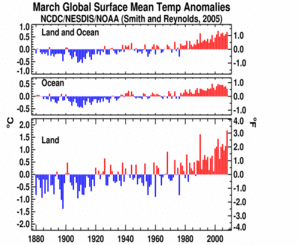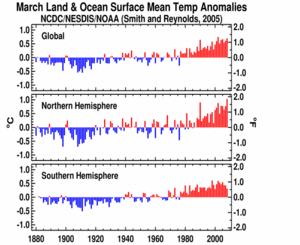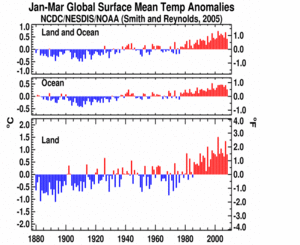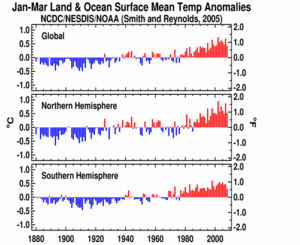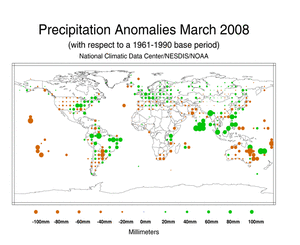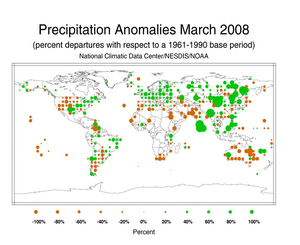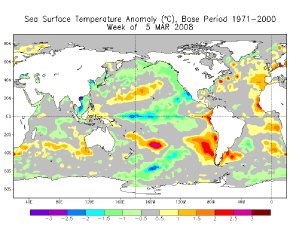Global Highlights:
- Based on preliminary data, the globally averaged combined land and sea surface temperature was the second warmest on record for March and the January-March year-to-date period ranked eleventh warmest.
- March 2008 temperatures were above average in Europe, Asia, northern Africa, central and southern Australia, parts of the southern states of the contiguous U.S, southern Alaska, and parts of South America. Cooler-than-average conditions occurred in Canada, northwestern, north-central and northeastern states of the contiguous U.S., eastern Australia, and parts of South Africa.
- Precipitation during March 2008 was above average in the Philippines, Sri Lanka, southern India, most of Europe and Brazil, and south-central, mid-western, and the northeast parts of the contiguous U.S. Drier-than-average conditions were observed in the Hawaiian Islands, parts of the southeastern U.S. and most of the central and western U.S., parts of the southern countries in South America, eastern and northern Australia, and southern Africa.
- Some weakening of La Niña occurred during March, but a moderate La Niña remained across the equatorial Pacific Ocean.
Contents of this Section:
The data presented in this report are preliminary. Ranks and anomalies may change as more complete data are received and processed. The most current data may be accessed via the Global Surface Temperature Anomalies page.
Introduction
Temperature anomalies for March 2008 are shown on the dot maps below. The dot map, below left, provides a spatial representation of anomalies calculated from the Global Historical Climatology Network (GHCN) data set of land surface stations using a 1961-1990 base period. The dot map, below right, is a product of a merged land surface and sea surface temperature anomaly analysis developed by Smith and Reynolds (2005). Temperature anomalies with respect to the 1961-1990 mean for land and ocean are analyzed separately and then merged to form the global analysis. Additional information on this product is available.
The January-March 2008 map shows that for the first three months of the year, anomalous warm conditions were present over much of the world's land surface, especially across Europe and northern Asia where temperatures were 2°-5°C (4°-9°F) above average. Elsewhere, cooler-than-average conditions were observed in parts of the western and north-central states of the contiguous U.S., north-central Africa, eastern Australia, and parts of central and southeast Asia. As for sea surface temperatures (SST), warmer-than-average conditions were present in the Atlantic and Indian oceans, the Niño 1+2 region, and parts of the northwest Pacific Ocean. Cooler-than-average conditions were observed in all of the Niño regions (with the exception of Niño 1+2 region), parts of the northeastern Pacific and some areas in the southern oceans.
During March, above average temperatures were observed across Europe, Asia, northern Africa, central and southern Australia, parts of the southern states of the contiguous U.S, southern Alaska, and parts of South America. As shown in the March 2008 map, temperatures across Europe and most of Asia were 2°-6°C (4°-11°F) above the 1961-1990 mean. Following the largest January snow cover extent on record for the Eurasian continent and for the Northern Hemisphere, the warm conditions in March over Europe and Asia were associated with the least snow cover extent on record for the Eurasian continent and the second least for the Northern Hemisphere. Meanwhile, cooler-than-average conditions were present across Canada, northwestern, north-central and northeastern states of the contiguous U.S., eastern Australia, and parts of South Africa.
According to the Bureau of Meteorology (BoM), South Australia experienced a record heat wave which brought scorching temperatures across the state. Adelaide, South Australia's capital, experienced the longest running heat wave on record, with 15 consecutive days of maximum temperatures above 35°C (95°F). This broke the previous record of 8 consecutive days which was tied on numerous occasions, most recently in February 2004. Also, Adelaide set a new record as having the longest number of consecutive days for all Australian state capital cities. The second longest number of consecutive days for all Australian state capital cities with temperatures greater than 35°C (95°F) was 10 days, set in February 1988 in the city of Perth. South Australia, overall, had the third warmest March since records began with 2.35°C (4.23°F) above the 1961-1990 average. Australia, as a whole, had the 16th warmest March on record with an anomaly of 0.79°C (1.42°F) above average. For more information on South Australia's heat wave, please visit the March Global Hazards page.
SSTs during March 2008 were warmer than average in the Atlantic, northwestern Pacific, eastern equatorial Pacific, and parts of the south Indian and south Pacific oceans. Cooler-than-average conditions were present in parts of the southern oceans, North Indian Ocean, and in the Niño regions, with the exception of the Niño 1+2 region where the monthly temperature anomaly rose to +0.82°C (+1.48°F). Temperatures across the Niño 3.4 and Niño 4 increased slightly but the anomalies remained below average. Please see the latest ENSO discussion for additional information.
The mean position of the upper level ridges of high pressure and troughs of low pressure (depicted by positive and negative 500-millibar height anomalies on the March map) are generally reflected by areas of positive and negative temperature anomalies at the surface, respectively. For other Global products, please see the Climate Monitoring Global Products page.
Images of sea surface temperature conditions are available for all weeks during 2008 at the weekly SST page.
Temperature Rankings and Graphics
Effective with the February 2006 report, NCDC transitioned from the use of the Operational Global Surface Temperature Index (Quayle et al. 1999) to the blended land and ocean dataset developed by Smith and Reynolds (2005). The differences between the two methods are discussed in Smith et al. (2005).
The combined global land and ocean surface temperature was the second warmest on record in March, behind 2002, and the eleventh warmest on record for January-March year-to-date period. Temperatures were warmer than average across Europe and Asia, prompting the March 2008 global and Northern Hemisphere land surface temperatures to be the warmest since records began in 1880. La Niña, the cold phase of the El Niño-Southern Oscillation, persisted in the equatorial Pacific, damping ocean surface temperatures. The global average ocean sea surface temperature (SST) in March was the 13th warmest on record. See the March global time series.
| March | Anomaly | Rank | Warmest (or Next Warmest) Year on Record |
|---|---|---|---|
GlobalLandOcean Land and Ocean |
+1.78°C (+3.20°F) +0.31°C (+0.56°F) +0.70°C (+1.26°F) |
warmest 13th warmest 2nd warmest |
1990 (+1.62°C/2.92°F) 1998 (+0.51°C/0.92°F) 2002 (+0.74°C/1.33°F) |
Northern HemisphereLandOcean Land and Ocean |
+2.24°C (+4.03°F) +0.31°C (+0.56°F) +1.03°C (+1.85°F) |
warmest 9th warmest warmest |
1990 (+2.00°C/3.60°F) 2004 (+0.49°C/0.88°F) 1990 (+0.91°C/1.64°F) |
Southern HemisphereLandOcean Land and Ocean |
+0.35°C (+0.63°F) +0.31°C (+0.56°F) +0.32°C (+0.58°F) |
22nd warmest 22nd warmest 22nd warmest |
1998 (+0.92°C/1.66°F) 2002 (+0.56°C/1.01°F) 1998 (+0.61°C/1.10°F) |
| January-March | Anomaly | Rank | Warmest (or Next Warmest) Year on Record |
|---|---|---|---|
GlobalLandOcean Land and Ocean |
+0.81°C (+1.46°F) +0.28°C (+0.50°F) +0.42°C (+0.76°F) |
11th warmest 14th warmest 11th warmest |
2002 (+1.51°C/2.72°F) 1998 (+0.53°C/0.95°F) 2002 (+0.73°C/1.31°F) |
Northern HemisphereLandOcean Land and Ocean |
+0.95°C (+1.71°F) +0.27°C (+0.49°F) +0.53°C (+0.95°F) |
10th warmest 11th warmest 8th warmest |
2002 (+1.89°C/3.40°F) 1998 (+0.50°C/0.90°F) 2002 (+0.95°C/1.71°F) |
Southern HemisphereLandOcean Land and Ocean |
+0.39°C (+0.70°F) +0.29°C (+0.52°F) +0.31°C (+0.56°F) |
14th warmest 23rd warmest 19th warmest |
1998 (+0.85°C/1.53°F) 1998 (+0.56°C/1.01°F) 1998 (+0.60°C/1.08°F) |
The most current data may be accessed via the Global Surface Temperature Anomalies page.
Precipitation
The maps below represent anomaly values based on the GHCN data set of land surface stations using a base period of 1961-1990. During March 2008, above average precipitation fell over areas that include the Philippines, Sri Lanka, southern India, most of Europe and Brazil, and the south-central, mid-western, and the northeast parts of the contiguous U.S. Drier-than-average conditions were observed across the Hawaiian Islands, eastern and northern Australia, and southern Africa, most of the central and western U.S. and parts of the southeastern U.S., and the southern countries in South America.
In the U.S., rainfall in the middle of March led to improving drought conditions in much of the Southeast, but at month's end, moderate to extreme drought remained over 59% of the region. Torrential rains during March 17-20 caused widespread flooding across the central U.S., prompting the overflow of rivers and causing historical floods. Across Kenya and Sri Lanka, heavy rains prompted floods that displaced thousands of people. Additional details on flooding and drought can also be found on the March Global Hazards page.
ENSO SST Analysis
Sea surface temperature (SST) anomalies in all of the Niño regions increased, but the Niño 3.4 and 4 regions anomalies remained below average. SST anomalies in the Niño 1+2 region rose to +0.82°C (1.48°F), a warming of +0.52°C (0.94°F) compared to February's anomaly. These conditions indicate that some weakening of La Niña (ENSO cold phase) occurred during March, but a moderate La Niña remained across the tropical Pacific Ocean (shown in the adjacent animation of weekly sea surface temperature anomalies). A comprehensive summary of March 2008 ENSO conditions can be found on the ENSO monitoring page. For the latest advisory on ENSO conditions go to NOAA's Climate Prediction center (CPC) and the CPC ENSO Diagnostic Discussion.
Images of sea surface temperature conditions are available for all weeks since 2003 at the weekly SST page.
References
Peterson, T.C. and R.S. Vose, 1997: An Overview of the Global Historical Climatology Network Database. Bull. Amer. Meteorol. Soc., 78, 2837-2849.
Quayle, R.G., T.C. Peterson, A.N. Basist, and C. S. Godfrey, 1999: An operational near-real-time global temperature index. Geophys. Res. Lett., 26, 333-335.
Smith, T.M., and R.W. Reynolds (2005), A global merged land air and sea surface temperature reconstruction based on historical observations (1880-1997), J. Clim., 18, 2021-2036.
 NOAA's National Centers for Environmental Information
NOAA's National Centers for Environmental Information
